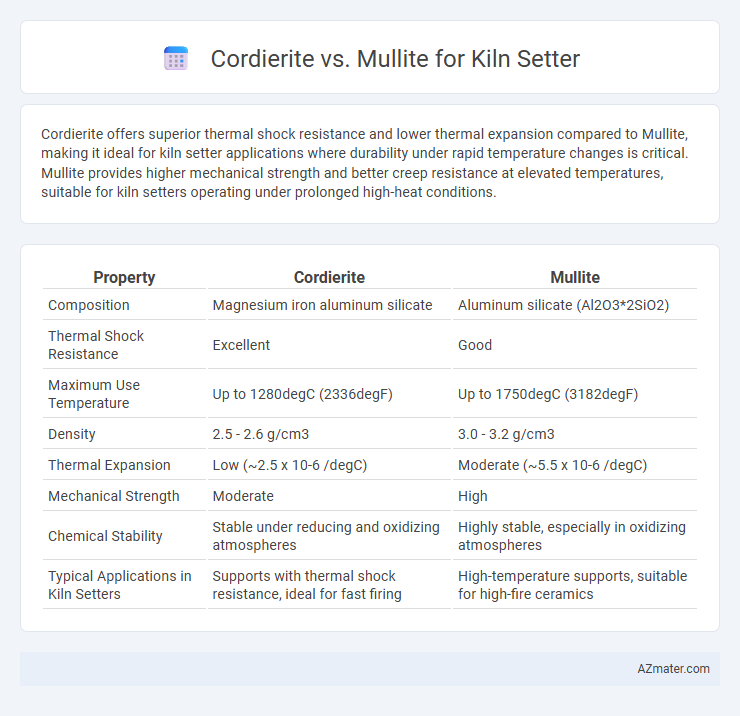Cordierite offers superior thermal shock resistance and lower thermal expansion compared to Mullite, making it ideal for kiln setter applications where durability under rapid temperature changes is critical. Mullite provides higher mechanical strength and better creep resistance at elevated temperatures, suitable for kiln setters operating under prolonged high-heat conditions.
Table of Comparison
| Property | Cordierite | Mullite |
|---|---|---|
| Composition | Magnesium iron aluminum silicate | Aluminum silicate (Al2O3*2SiO2) |
| Thermal Shock Resistance | Excellent | Good |
| Maximum Use Temperature | Up to 1280degC (2336degF) | Up to 1750degC (3182degF) |
| Density | 2.5 - 2.6 g/cm3 | 3.0 - 3.2 g/cm3 |
| Thermal Expansion | Low (~2.5 x 10-6 /degC) | Moderate (~5.5 x 10-6 /degC) |
| Mechanical Strength | Moderate | High |
| Chemical Stability | Stable under reducing and oxidizing atmospheres | Highly stable, especially in oxidizing atmospheres |
| Typical Applications in Kiln Setters | Supports with thermal shock resistance, ideal for fast firing | High-temperature supports, suitable for high-fire ceramics |
Introduction to Kiln Setters
Kiln setters are critical components in kiln operations, designed to accurately control firing cycles by detecting temperature changes. Cordierite offers excellent thermal shock resistance and low thermal expansion, making it suitable for precise kiln setters subjected to rapid temperature fluctuations. Mullite provides high-temperature stability and mechanical strength, ideal for kiln setters in environments requiring prolonged exposure to extreme heat.
Overview of Cordierite and Mullite
Cordierite and Mullite are both ceramic materials widely used in kiln setters for their excellent thermal stability and resistance to thermal shock. Cordierite, characterized by its low thermal expansion and high resistance to thermal shock, is ideal for applications requiring rapid temperature changes. Mullite offers superior strength, high-temperature stability, and excellent resistance to chemical corrosion, making it suitable for long-term use in demanding kiln environments.
Material Composition Differences
Cordierite is a magnesium iron aluminum cyclosilicate primarily composed of Mg2Al4Si5O18, offering excellent thermal shock resistance due to its inherent crystalline structure. Mullite consists mainly of 3Al2O3 * 2SiO2, providing superior mechanical strength and high-temperature stability but lower thermal shock resistance compared to Cordierite. The distinct alumina to silica ratios influence their thermal expansion and durability, making Cordierite ideal for rapid heating and cooling cycles while Mullite excels in prolonged high-temperature applications in kiln setters.
Thermal Shock Resistance Comparison
Cordierite exhibits superior thermal shock resistance compared to mullite, making it highly effective for kiln setter applications where rapid temperature fluctuations occur. Its low thermal expansion coefficient minimizes stress and cracking during sudden heat changes, whereas mullite, with higher thermal expansion, is more prone to thermal shock damage. This makes cordierite the preferred choice in kiln setters requiring durability and reliability under extreme thermal cycling conditions.
Mechanical Strength and Durability
Cordierite offers excellent thermal shock resistance with moderate mechanical strength, making it ideal for kiln setters exposed to rapid temperature changes. Mullite exhibits superior mechanical strength and higher durability under prolonged high-temperature conditions, ensuring long-term structural stability in industrial kiln applications. Choosing between cordierite and mullite depends on the specific thermal cycling demands and mechanical load requirements of the kiln environment.
Maximum Working Temperature
Cordierite offers a maximum working temperature typically around 1275degC (2327degF), while Mullite can withstand higher temperatures up to approximately 1750degC (3182degF). This makes Mullite more suitable for kiln setters in high-temperature applications, ensuring better thermal stability and durability. Choosing Mullite can significantly enhance performance in kilns operating at elevated temperatures.
Chemical Resistance and Reactivity
Cordierite exhibits excellent chemical resistance, particularly against alkalis and acidic slags, making it highly stable in kiln setter applications exposed to reactive atmospheres. Mullite offers superior resistance to high-temperature chemical attack and is less prone to corrosion by molten metals and glass, enhancing longevity in aggressive kiln environments. Both materials demonstrate low reactivity; however, mullite's higher thermal stability and chemical inertness provide better durability when encountering fluctuating kiln atmospheres containing reactive gases.
Cost and Availability Factors
Cordierite kilns setters are generally more cost-effective due to their widespread availability and common use in ceramic firing, while mullite setters tend to be pricier because of their higher temperature resistance and specialized applications. Cordierite is mass-produced, making it readily accessible for hobbyists and commercial users, whereas mullite can be harder to source and often requires custom orders for certain kiln models. Choosing between the two depends largely on budget constraints and the specific firing temperature range, with cordierite favored for moderate temperatures and mullite preferred for high-temperature industrial settings.
Applications in Kiln Firing Processes
Cordierite and mullite are essential materials in kiln setter applications due to their exceptional thermal stability and low thermal expansion, which minimize deformation during high-temperature firing cycles. Cordierite is prized for its excellent resistance to thermal shock, making it ideal for rapid heating and cooling processes commonly seen in ceramic and glass kiln operations. Mullite offers superior mechanical strength and creep resistance at elevated temperatures, making it suitable for prolonged firing schedules where structural integrity is critical.
Choosing the Best Material for Kiln Setters
Cordierite and mullite are both popular materials for kiln setters, with cordierite offering superior thermal shock resistance and mullite excelling in high-temperature stability and mechanical strength. Selecting the best material depends on kiln operating conditions; cordierite is ideal for rapid temperature changes up to 1300degC, while mullite withstands prolonged exposure above 1400degC without deformation. Evaluating specific kiln firing cycles and temperature ranges ensures optimal durability and performance of the kiln setter.

Infographic: Cordierite vs Mullite for Kiln Setter
 azmater.com
azmater.com